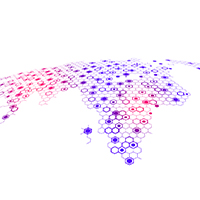The critical role of collaboration in advancing precision medicine
Precision medicine holds the promise of tailored treatments, faster diagnoses, and longer, healthier lives. But what happens when new technology meets a fragmented system? Despite groundbreaking advancements in artificial intelligence (AI) and machine learning (ML), progress stalls when researchers, clinicians, and technology innovators operate in silos. The true barrier isn't the technology – it's the lack of alignment among those driving it forward. Without collaboration, the full potential of precision medicine could remain just out of reach.
This fragmentation runs deep, spanning researchers, clinicians, pharmaceutical companies, and even the innovators behind the very technologies meant to drive progress. The result is a domino effect: innovation slows, and the impact of groundbreaking tools diminishes. To unlock the full potential of AI and ML in precision medicine, stakeholders must break down these barriers and confront the coordination challenges plaguing the ecosystem.
The missed opportunity in precision medicine
AI and ML are pushing the boundaries of what's possible in precision medicine – processing vast datasets, uncovering hidden patterns, and predicting outcomes with unprecedented accuracy. Once the stuff of science fiction, these technologies transform how diseases are diagnosed, and new treatments are developed. Yet, despite their potential, progress stalls when stakeholders fail to align. Siloed data, conflicting objectives, and a lack of standardised processes prevent these innovations from reaching full impact.
Misalignment often arises when different stakeholders pursue goals without shared priorities. For example, researchers may develop AI algorithms capable of detecting specific biomarkers, but clinicians may struggle to determine whether these findings are clinically actionable – limiting their real-world application. Similarly, pharmaceutical companies may focus on long-term objectives, such as developing new treatments, which can take 10 to 15 years, while technology developers prioritise short-term goals, such as expanding the scalability of their software. Without coordination, these disparate efforts create a fragmented ecosystem where technological advancements fail to translate into meaningful patient outcomes.
This disconnect is particularly critical in fields like oncology and rare diseases, where timely and precise interventions can mean the difference between life and death. Without better alignment, the promise of AI-driven precision medicine will remain unrealised, leaving life-saving breakthroughs just out of reach.
The human coordination problem
The cornerstone of stakeholder fragmentation lies not within the ones and zeros of technology but within the people using it. Simply put, the most significant barrier to coordination is human behaviour. Bridging the gaps between stakeholders requires more than technological advancements – it demands a cultural shift toward collaboration.
There are three primary challenges limiting success in precision medicine:
- Misaligned objectives and priorities: Across the industry, stakeholders such as researchers, clinicians, and pharmaceutical companies often pursue conflicting goals. For example, researchers may focus on cutting-edge discoveries, clinicians need practical patient care tools, and pharmaceutical companies may prioritise long-term drug development. These misaligned objectives create a fragmented ecosystem where progress is slow and inefficient.
- Entrapped information: Data silos and incompatible systems are a recurring problem across healthcare. When critical information cannot be shared across disciplines, it triggers a domino effect of inefficiencies – stifling research, delaying breakthroughs, and hindering treatment improvements.
- Increasing technological complexity: While AI and ML unlock new possibilities, their growing complexity can alienate users. Without proper training or support, stakeholders may feel these technologies are beyond their scope, leading to disinterest and slow adoption.
A call for collaboration
Despite these challenges, solutions are within reach. A multi-pronged approach can break down silos, align priorities, and empower stakeholders to drive progress together:
- Establishing baselines for success: Defining shared goals is the first step toward alignment. When researchers, clinicians, and pharmaceutical developers synchronise their efforts around common objectives – such as improving patient outcomes – each contribution builds toward a collective impact. Establishing these baselines ensures that progress in one area reinforces the others, addressing the issue of misaligned objectives.
- Standardising data-sharing frameworks: Overcoming data silos requires adopting centralised, secure platforms that facilitate cross-disciplinary data sharing. These platforms should prioritise safety and privacy protocols while enabling system interoperability. A shared data ecosystem fosters richer datasets, enhances AI and ML capabilities, and accelerates discoveries across the healthcare spectrum.
- Expanding dialogue and cross-training: Technological advancement often comes with a learning curve. Open dialogue and knowledge-sharing sessions between stakeholders can drive understanding and spark collaboration. Cross-training programmes further break down barriers, empowering stakeholders to engage with advanced technologies confidently. Together, these efforts cultivate a culture where innovation and technological adoption can thrive.
Case studies in collaborative success
Real-world initiatives highlight the power of collaboration in breaking down barriers while also driving meaningful progress, especially in areas where intervention is a race against time such as oncology or rare diseases. One such example is the Cancer Moonshot Initiative, which was launched in 2016. This ambitious program united researchers, clinicians, and industry leaders to accelerate cancer research. By promoting collaborative efforts and data sharing, the initiative has driven significant advancements in cancer prevention, diagnosis, and treatment.
Similarly, the All of Us Research programme led by the National Institutes of Health (NIH), aims to advance precision medicine by collecting data from one million diverse participants. The program has built a comprehensive resource advancing inclusive research and care by engaging a wide range of stakeholders – from clinicians to patient advocates.
The rise of generative AI has fueled partnerships between AI research organisations and healthcare institutions. Collaborations such as OpenAI and the Los Alamos National Laboratory demonstrate how combining technical expertise with clinical insight can yield transformative outcomes. AI models trained on real-world clinical data are now assisting in predicting disease progression and identifying potential drug targets, demonstrating how cross-industry collaboration accelerates innovation.
The path forward
The true power of precision medicine lies not only in advanced tools but in the collective effort of those using them. The industry's ability to achieve its full potential depends on moving beyond fragmentation and embracing collaboration. Stakeholders must recognise that their individual contributions, while valuable, are only pieces of a larger puzzle. By aligning goals, sharing knowledge, and working together, the complete picture of what precision medicine can achieve will come into view – transforming patient outcomes and driving the future of healthcare forward.
About the authors
Jamie Littlejohns, CEO, Velsera
Jamie Littlejohns joined Velsera in January 2024, having previously provided external support to the company and its founding business since early 2022. He has worked in healthcare and life sciences since 2010 and previously was a partner at McKinsey & Company, where he spent over a decade and led their Health & Life Science Investing Practice in Europe, specialising in supporting investor-backed health and life science tech businesses on their scale-up journeys.
Supercharge your pharma insights: Sign up to pharmaphorum's newsletter for daily updates, weekly roundups, and in-depth analysis across all industry sectors.
Want to go deeper?
Continue your journey with these related reads from across pharmaphorum
Click on either of the images below for more articles from this edition of Deep Dive: Market Access and Commercialisation 2025













